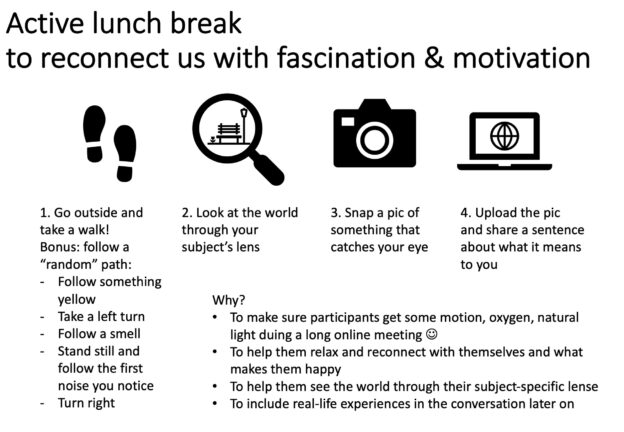I often teach faculty development workshops at Kiel University. Since we have been in remote teaching mode almost exclusively since March 2020, dealing with virtual classes is a pressing subject – both for the faculty who attend my workshops, but also for myself as I have to present best practice examples of leading fully-virtual all-day workshops.
I got the idea I will present here from David Morgan (this is his implementation) during the September 2020 “FieldWorkFix during Covid-19” conference, where I experienced the “active lunch break” as a participant. I remember being slightly annoyed that people were trying to hijack my lunch break (which already started out an hour late due to the time difference!), and that I did not completely follow the instructions. David asked us to follow a quasi-random, “bias-free” path determined by “wandering cards” (e.g. “follow something yellow”, “take a right turn”, “sit down for 2 minutes and see what happens”) in order to get us off our well-trodden paths to make it easier to see the world with different eyes and also to lower the threshold of picking something that we feel needs to count as a good example with a clear connection to our subject. So no pressure to go running to the botanical gardens for the biologists, or the beach for the oceanographers! I thought “it’s my lunch break after all, so I will do what I please!” and went the straight down to Kiel fjord, as I do every day. I then took a photo as instructed, “using my subject area as my lens”, and uploaded it to the website. I started the second half of the day with newfound energy and inspiration, glad that I had gotten over my internal resistance and participated.
I have since used a similar active lunch break in three full-day faculty development workshops with approximately 15 participants each. Every time, right before the 1-hour lunch break, I introduce the task. I ask them to take the opportunity to step away from their screens for a bit instead of catching up on email, to get some movement, some natural light, some oxygen. I state that I know that it’s a bit of a leap of faith to spend their lunch break “my way”, but that I would really encourage them to at least step out on their balcony and find *something* that they notice as an expert in their fields, to take a picture and to upload it in a shared google slides document. I share examples of what we did during that initial workshop and of what participants in previous workshops did. I then start the lunch break and anxiously run outside to at least do the task myself, even if everybody else might choose not to. I tell myself that if nobody actually ended up doing the task, it would be a great opportunity to talk about why students might choose to not do the tasks they are given.
As I am walking, I always find something that fascinates me and that I can relate to my interest in oceanography. I take a picture, also take in the nature around me, and relax. I come back and upload the picture, adding a short description of what what the picture shows looks like through my eyes. Then, slowly, the participants return and usually more than 4 out of 5 upload a picture.
When everybody is back and the break is over, I ask them about how it went for them. Each time, someone mentions that they would not have taken the time to take a real break and go outside, had I not encouraged it and connected it to a task that they felt obliged to work on. Then, someone says how they at first thought that it would be impossible to find something to take a picture of, because their research field is so specialized and abstract, and how they were then excited to see something and feel like they were noticing a connection to their field that would be invisible to others, and how that reminded them of how very cool they thought their field was. And someone says how they want to use it on their own students if they have to teach full days and really want to make sure they include a real break.
The kind of pictures that people bring back are very different. For me as an oceanographer as well as for other people in geosciences, it is very easy to relate puddles on the street to the ocean, or children’s windmills to measurements of atmospheric properties. A professor in chemistry took a picture of a climbing rope web on a playground and related it to the crystal structures he is studying. Linguists bring pictures of election posters or advertisements with slogans on them, of flowers that remind them of medieval poetry, of a flower behind a fence that elicits the idea how reading can free the mind. An ecologist showed a picture of a bird’s nest in her conservatory as an example of contextuality of reproduction decisions: Starting to build the nest there seemed a good decision at the time, but then the weather changed and what used to be a secluded and quiet place became a high traffic area for children. Looking through those pictures with the participants is a joyful excursion into the way other people perceive the world, full of wonder and a sense of exploration and excitement.
I really like this “active lunch break” task because of the effect it has on my participants, and on me! So much so that I use this method “just on myself” on long working days, and I have never regretted doing it :)
Have you ever tried something similar? Would you?

Pingback: An iEarth teaching conversation with Kjersti Daae and Torgny Roxå on #WaveWatching - Adventures in Oceanography and Teaching